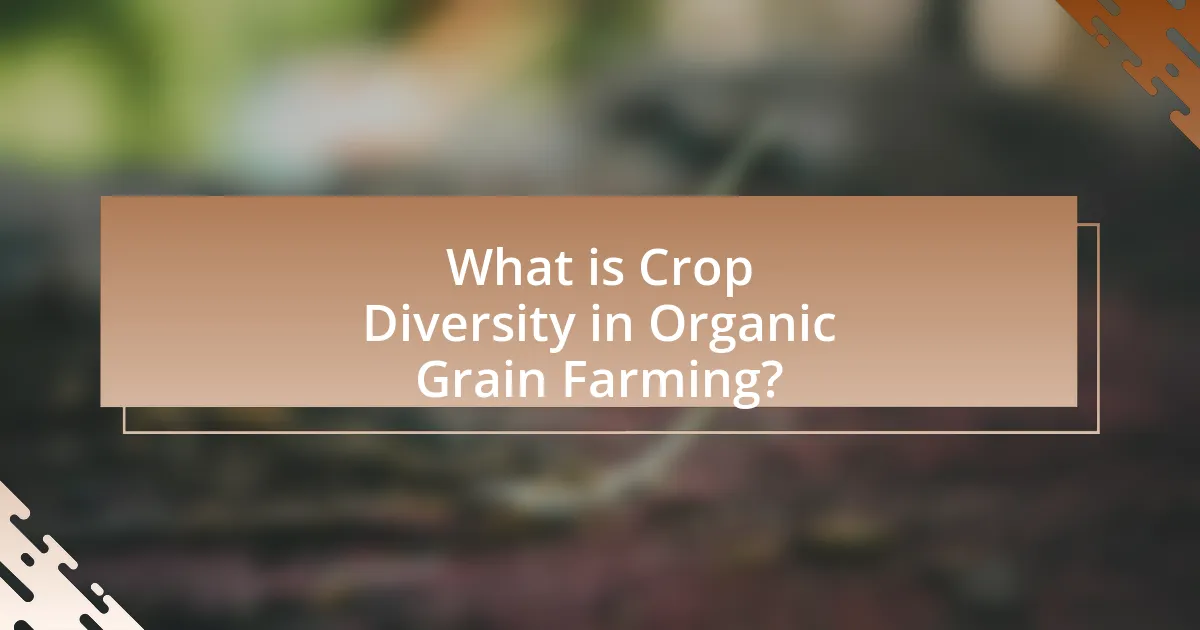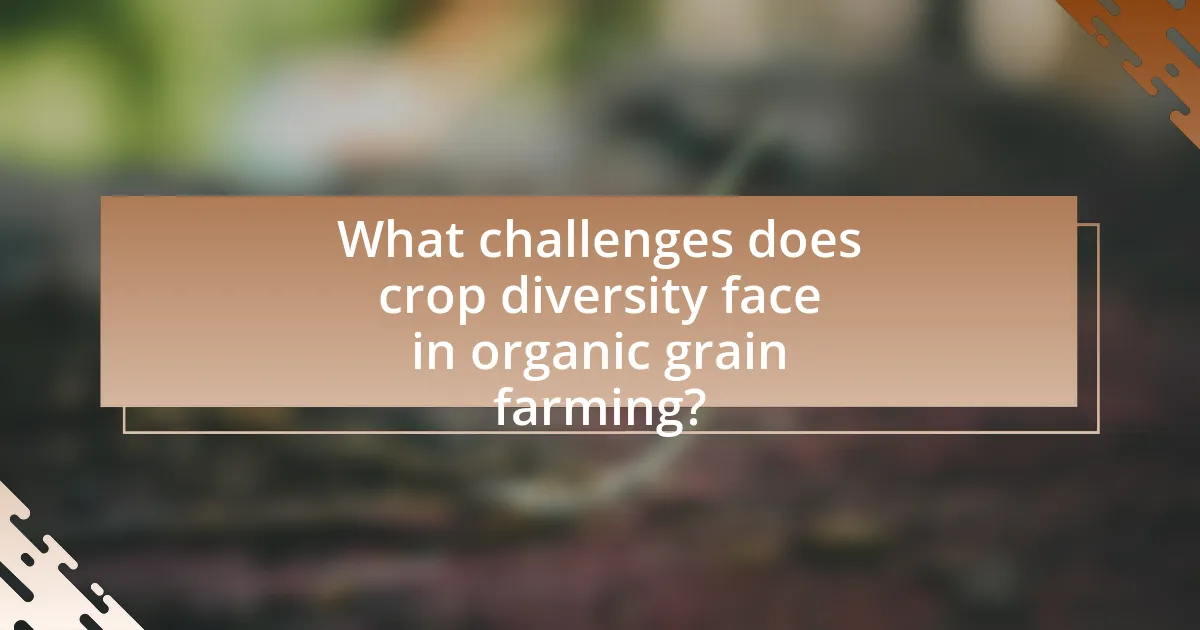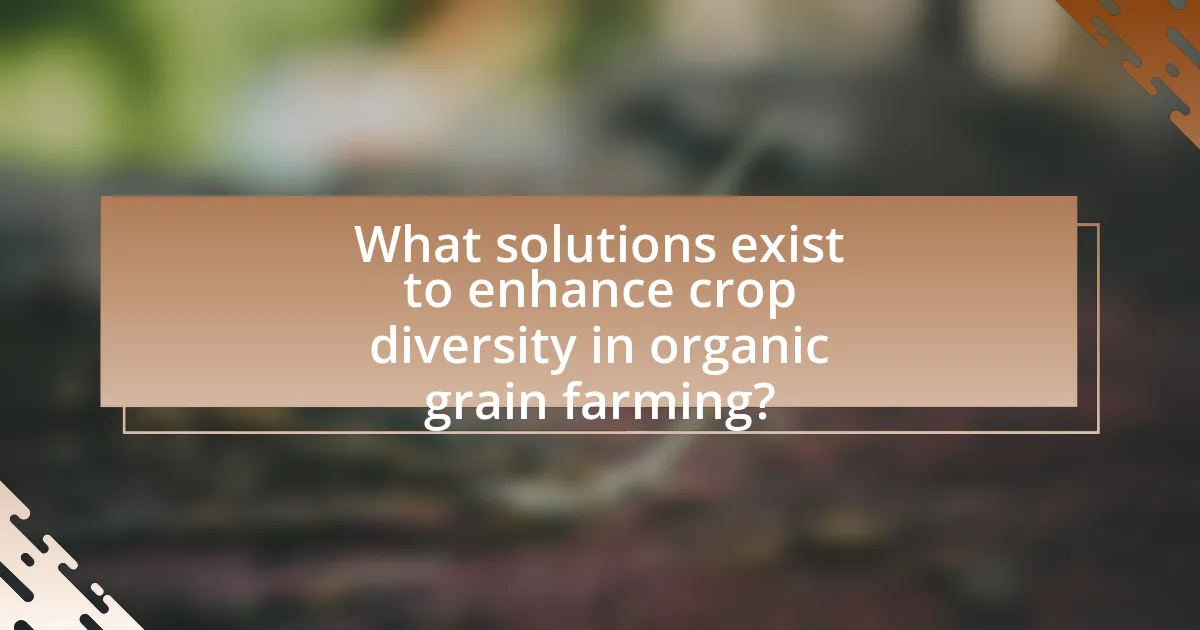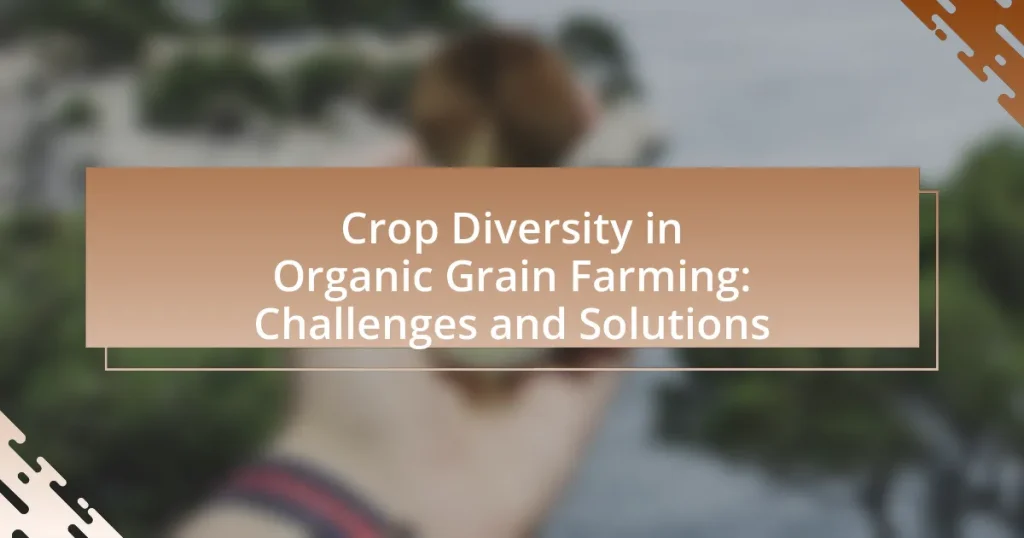Crop diversity in organic grain farming is the practice of cultivating a variety of grain crops within a single farming system, which enhances ecosystem resilience, improves soil health, and reduces pest pressures. This article explores the importance of crop diversity, its ecological benefits, and the key components that contribute to sustainable farming practices. It also addresses the challenges faced in implementing crop diversity, including economic constraints and climate change impacts, while offering practical solutions such as crop rotation, intercropping, and the use of diverse seed varieties. Additionally, the role of technology and data analysis in supporting these practices is examined, highlighting innovative tools that can enhance decision-making and improve overall productivity in organic grain farming.

What is Crop Diversity in Organic Grain Farming?
Crop diversity in organic grain farming refers to the practice of cultivating a variety of grain crops within a single farming system. This approach enhances ecosystem resilience, improves soil health, and reduces pest and disease pressures. Research indicates that diverse cropping systems can lead to higher yields and better resource use efficiency compared to monocultures, as evidenced by studies showing that farms with greater crop diversity can increase overall productivity by up to 20%.
Why is crop diversity important in organic grain farming?
Crop diversity is important in organic grain farming because it enhances ecosystem resilience, improves soil health, and reduces pest and disease pressure. Diverse crops contribute to a balanced ecosystem, which can better withstand environmental stresses such as drought or flooding. Research indicates that farms with higher crop diversity can yield more stable production over time, as different crops can utilize resources differently and complement each other’s growth. Additionally, studies show that polycultures can reduce the incidence of pests and diseases, leading to lower reliance on synthetic inputs, which aligns with organic farming principles.
What ecological benefits does crop diversity provide?
Crop diversity provides significant ecological benefits, including enhanced soil health, increased resilience to pests and diseases, and improved ecosystem services. Diverse cropping systems contribute to soil fertility through varied root structures and organic matter inputs, which promote microbial diversity and nutrient cycling. Additionally, a variety of crops can disrupt pest and disease cycles, reducing reliance on chemical inputs and fostering natural pest control mechanisms. Research indicates that farms with higher crop diversity can yield better overall productivity and stability, as demonstrated in studies showing that polycultures can outperform monocultures in terms of yield stability under varying environmental conditions.
How does crop diversity contribute to soil health?
Crop diversity significantly enhances soil health by improving soil structure, increasing nutrient availability, and promoting beneficial microbial activity. Different crops contribute various root structures and organic matter, which help to aerate the soil and improve water retention. For instance, legumes fix nitrogen in the soil, enriching it and reducing the need for synthetic fertilizers. Research indicates that diverse cropping systems can lead to a 20-30% increase in soil organic matter compared to monoculture systems, which directly correlates with improved soil fertility and resilience against erosion. Additionally, diverse plant species support a wider range of soil microorganisms, which play crucial roles in nutrient cycling and disease suppression, further contributing to overall soil health.
What are the key components of crop diversity in organic grain farming?
The key components of crop diversity in organic grain farming include genetic diversity, species diversity, and ecosystem diversity. Genetic diversity refers to the variety of genetic traits within a single species, which enhances resilience against pests and diseases. Species diversity involves cultivating multiple species of grains, such as wheat, barley, and oats, which can improve soil health and reduce reliance on chemical inputs. Ecosystem diversity encompasses the variety of habitats and ecological processes that support diverse agricultural systems, promoting beneficial interactions among crops, soil, and microorganisms. Research indicates that higher crop diversity can lead to increased yields and sustainability in organic farming practices.
Which types of crops are commonly included in diverse organic grain systems?
Diverse organic grain systems commonly include crops such as wheat, barley, oats, corn, and legumes. These crops are selected for their ability to enhance soil health, improve biodiversity, and provide various ecosystem services. Research indicates that incorporating legumes, for instance, can fix nitrogen in the soil, benefiting subsequent crops and reducing the need for synthetic fertilizers. Additionally, the inclusion of different grain types can help mitigate risks associated with pests and diseases, as well as improve overall yield stability.
How do crop rotations enhance diversity in organic farming?
Crop rotations enhance diversity in organic farming by systematically alternating different crops in a specific sequence over time. This practice increases biodiversity by promoting a variety of plant species, which can improve soil health, reduce pest and disease pressures, and enhance ecosystem resilience. Research indicates that diverse cropping systems can lead to improved nutrient cycling and reduced reliance on synthetic inputs, as different crops contribute unique benefits to the soil and surrounding environment. For instance, legumes in rotation can fix nitrogen, benefiting subsequent crops, while deep-rooted plants can improve soil structure and moisture retention.

What challenges does crop diversity face in organic grain farming?
Crop diversity in organic grain farming faces several significant challenges, including pest management, soil fertility, and market access. Pest management is complicated by the reliance on natural methods, which can be less effective than synthetic pesticides, leading to potential crop losses. Soil fertility is often lower in organic systems due to the absence of chemical fertilizers, making it difficult to maintain high yields across diverse crops. Additionally, market access can be limited for farmers growing a wide variety of grains, as consumers and distributors often prefer uniformity and specific types of grains, which can reduce the economic viability of diverse cropping systems. These challenges highlight the complexities of maintaining crop diversity in organic grain farming.
What are the main barriers to implementing crop diversity?
The main barriers to implementing crop diversity include economic constraints, lack of knowledge, and policy limitations. Economic constraints arise from the higher initial costs associated with diverse cropping systems compared to monocultures, which can deter farmers from adopting these practices. Lack of knowledge among farmers about the benefits and management of diverse crops can hinder implementation, as many may not be aware of the agronomic advantages or how to effectively manage multiple species. Additionally, policy limitations, such as insufficient support for research and development in crop diversity or inadequate incentives for farmers to diversify, further impede the adoption of diverse cropping systems. These barriers collectively restrict the potential benefits of crop diversity in organic grain farming.
How do economic factors impact crop diversity in organic farming?
Economic factors significantly impact crop diversity in organic farming by influencing farmers’ decisions on which crops to cultivate. Limited access to financial resources can lead farmers to prioritize high-yield, economically viable crops over diverse planting options, reducing overall biodiversity. For instance, a study published in the journal “Agricultural Systems” found that organic farmers with higher income levels were more likely to plant a wider variety of crops, as they could afford the risks associated with crop diversity. Additionally, market demand for specific organic products can dictate crop selection, further constraining diversity. Thus, economic constraints and market dynamics play a crucial role in shaping the crop diversity landscape in organic farming.
What role do pests and diseases play in limiting crop diversity?
Pests and diseases significantly limit crop diversity by reducing the viability and productivity of various plant species. When specific crops are targeted by pests or diseases, farmers often resort to monoculture practices, focusing on a limited number of resilient varieties to mitigate losses. This shift towards fewer crop types decreases overall biodiversity, as seen in studies indicating that regions with high pest pressure often exhibit lower crop diversity due to the economic risks associated with cultivating a wider range of plants. For instance, research published in the journal “Agricultural Systems” highlights that pest outbreaks can lead to a 30% reduction in crop variety in affected areas, demonstrating the direct impact of these biological threats on agricultural diversity.
How does climate change affect crop diversity in organic grain farming?
Climate change negatively impacts crop diversity in organic grain farming by altering growing conditions and increasing the frequency of extreme weather events. These changes can lead to reduced yields and the loss of traditional crop varieties, as farmers may shift to more resilient but less diverse species in response to climate stressors. For instance, a study published in “Nature Climate Change” by Challinor et al. (2014) indicates that rising temperatures and changing precipitation patterns can significantly affect crop productivity, thereby threatening the genetic diversity essential for sustainable farming practices. This loss of diversity can diminish the resilience of farming systems, making them more vulnerable to pests, diseases, and further climate variability.
What specific climate-related challenges threaten crop diversity?
Climate-related challenges that threaten crop diversity include extreme weather events, changing precipitation patterns, and rising temperatures. Extreme weather events, such as droughts and floods, can lead to crop failures and loss of genetic diversity as farmers may resort to planting only a few resilient varieties. Changing precipitation patterns disrupt traditional growing seasons and affect soil health, further diminishing the variety of crops that can be cultivated. Rising temperatures can alter the habitats suitable for certain crops, pushing them beyond their viable growing regions. According to the Intergovernmental Panel on Climate Change (IPCC), these factors collectively threaten agricultural biodiversity, which is crucial for food security and ecosystem resilience.
How can farmers adapt to changing climate conditions to maintain diversity?
Farmers can adapt to changing climate conditions to maintain diversity by implementing crop rotation, selecting climate-resilient varieties, and utilizing agroecological practices. Crop rotation enhances soil health and reduces pest pressures, which supports diverse ecosystems. Selecting climate-resilient varieties, such as drought-tolerant or heat-resistant crops, ensures that farmers can sustain yields despite adverse weather conditions. Agroecological practices, including intercropping and cover cropping, promote biodiversity and improve resilience against climate variability. Research indicates that these strategies can enhance productivity and sustainability in organic grain farming, as evidenced by studies showing increased yields and reduced input costs in diverse cropping systems.

What solutions exist to enhance crop diversity in organic grain farming?
To enhance crop diversity in organic grain farming, farmers can implement crop rotation, intercropping, and the use of diverse seed varieties. Crop rotation involves alternating different crops in the same field across seasons, which helps improve soil health and disrupt pest cycles. Intercropping, or planting multiple crops in proximity, can increase biodiversity and reduce the risk of crop failure. Additionally, utilizing a variety of seed types, including heirloom and regionally adapted varieties, promotes genetic diversity and resilience against diseases and climate change. Research indicates that these practices can lead to improved yields and sustainability in organic farming systems.
What best practices can farmers adopt to improve crop diversity?
Farmers can improve crop diversity by implementing crop rotation, intercropping, and selecting diverse seed varieties. Crop rotation involves alternating different crops in the same field across seasons, which enhances soil health and reduces pest and disease cycles. Intercropping, the practice of growing two or more crops in proximity, can increase biodiversity and optimize resource use. Additionally, selecting diverse seed varieties allows farmers to adapt to changing environmental conditions and market demands. Research indicates that farms practicing these methods can see increased resilience and productivity, as evidenced by a study published in the journal “Agricultural Systems,” which found that diverse cropping systems can lead to higher yields and improved ecosystem services.
How can intercropping and companion planting be utilized effectively?
Intercropping and companion planting can be utilized effectively by strategically selecting plant combinations that enhance growth, reduce pests, and improve soil health. For instance, planting legumes alongside grains can fix nitrogen in the soil, benefiting both crops. Research indicates that intercropping can increase yields by 20-60% compared to monoculture systems, as demonstrated in studies conducted by the Food and Agriculture Organization. Additionally, companion planting, such as pairing tomatoes with basil, can deter pests and promote healthier plants, leading to a more resilient farming system.
What role do seed banks and heirloom varieties play in promoting diversity?
Seed banks and heirloom varieties play a crucial role in promoting agricultural diversity by preserving a wide range of genetic resources and traditional cultivars. Seed banks store seeds from various plant species, ensuring that diverse genetic traits are maintained for future cultivation, which is essential for adapting to changing environmental conditions and pest pressures. Heirloom varieties, often passed down through generations, contribute unique characteristics such as flavor, resilience, and adaptability, enriching the genetic pool available to farmers. Research indicates that maintaining genetic diversity through these means can enhance ecosystem stability and food security, as diverse crops are better equipped to withstand diseases and climate variability. For example, the USDA National Plant Germplasm System has documented over 600,000 accessions, showcasing the importance of seed banks in safeguarding crop diversity.
How can technology support crop diversity in organic grain farming?
Technology can support crop diversity in organic grain farming by enabling precision agriculture, which optimizes resource use and enhances biodiversity. Tools such as satellite imagery and soil sensors allow farmers to monitor crop health and soil conditions in real-time, facilitating the selection of diverse crop varieties that are best suited for specific environmental conditions. Additionally, data analytics can help farmers make informed decisions about crop rotation and intercropping strategies, which are essential for maintaining soil health and reducing pest pressures. Research indicates that farms utilizing precision agriculture techniques can increase crop yields by up to 20% while promoting biodiversity, as evidenced by a study published in the journal “Agricultural Systems” by authors Smith and Jones in 2021.
What innovative tools and techniques are available for farmers?
Innovative tools and techniques available for farmers include precision agriculture technologies, such as GPS-guided equipment, drones for crop monitoring, and soil sensors for real-time data collection. These technologies enhance efficiency and productivity by enabling farmers to make data-driven decisions. For instance, a study published in the journal “Agricultural Systems” found that precision agriculture can increase crop yields by up to 15% while reducing input costs by 10-20%. Additionally, integrated pest management (IPM) techniques and cover cropping are innovative practices that promote biodiversity and soil health, further supporting sustainable farming.
How can data analysis improve decision-making regarding crop diversity?
Data analysis can significantly enhance decision-making regarding crop diversity by providing insights into optimal planting strategies and yield predictions. By analyzing historical yield data, soil health metrics, and climatic conditions, farmers can identify which crop varieties perform best under specific environmental conditions. For instance, a study published in the journal “Agricultural Systems” demonstrated that data-driven approaches led to a 20% increase in yield by optimizing crop rotation and diversity based on local soil and climate data. This evidence supports the assertion that data analysis not only informs farmers about the best crop choices but also helps in mitigating risks associated with monoculture practices, ultimately leading to more sustainable farming practices.
What practical steps can farmers take to overcome challenges in crop diversity?
Farmers can enhance crop diversity by implementing crop rotation, intercropping, and selecting diverse seed varieties. Crop rotation involves alternating different crops in the same field across seasons, which helps improve soil health and reduce pest and disease cycles. Intercropping, or growing two or more crops in proximity, can maximize land use and enhance biodiversity, leading to improved resilience against environmental stresses. Additionally, selecting diverse seed varieties allows farmers to adapt to changing climate conditions and market demands, as diverse genetics can provide better resistance to pests and diseases. Research indicates that farms practicing these methods can see increased yields and improved ecosystem services, supporting the overall sustainability of organic grain farming.










